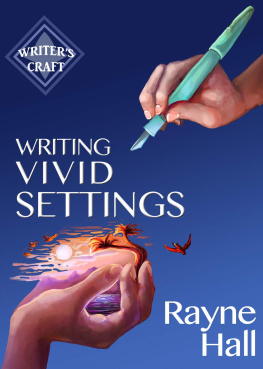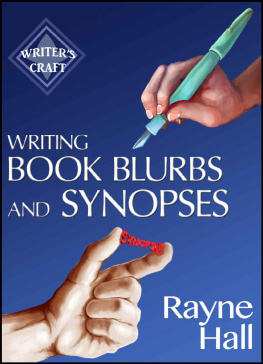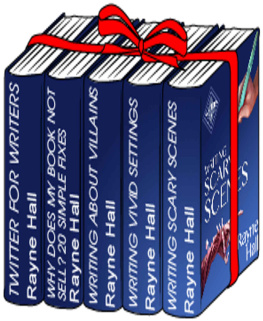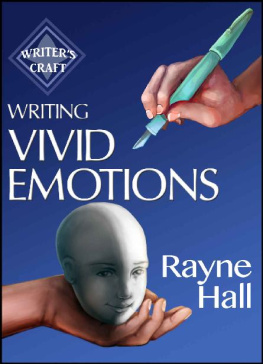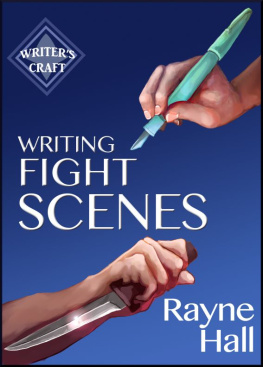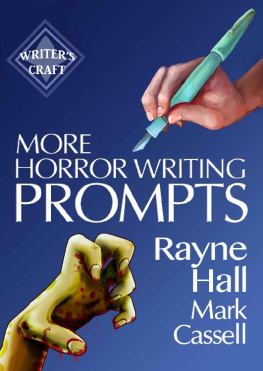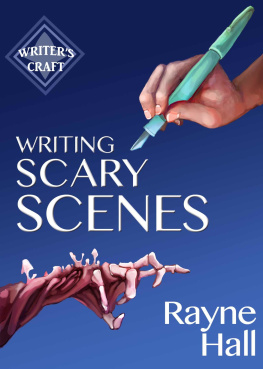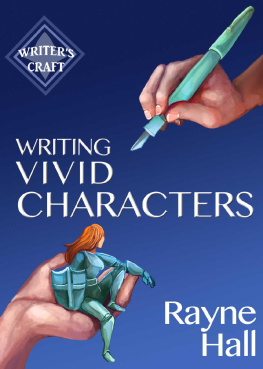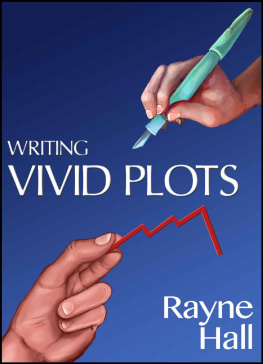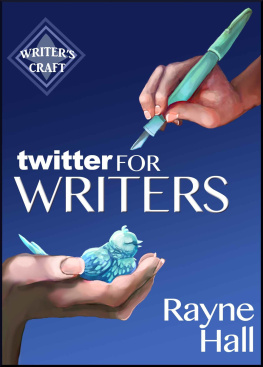Rayne Hall - Writing Vivid Settings
Here you can read online Rayne Hall - Writing Vivid Settings full text of the book (entire story) in english for free. Download pdf and epub, get meaning, cover and reviews about this ebook. year: 0, genre: Children. Description of the work, (preface) as well as reviews are available. Best literature library LitArk.com created for fans of good reading and offers a wide selection of genres:
Romance novel
Science fiction
Adventure
Detective
Science
History
Home and family
Prose
Art
Politics
Computer
Non-fiction
Religion
Business
Children
Humor
Choose a favorite category and find really read worthwhile books. Enjoy immersion in the world of imagination, feel the emotions of the characters or learn something new for yourself, make an fascinating discovery.
- Book:Writing Vivid Settings
- Author:
- Genre:
- Year:0
- Rating:3 / 5
- Favourites:Add to favourites
- Your mark:
- 60
- 1
- 2
- 3
- 4
- 5
Writing Vivid Settings: summary, description and annotation
We offer to read an annotation, description, summary or preface (depends on what the author of the book "Writing Vivid Settings" wrote himself). If you haven't found the necessary information about the book — write in the comments, we will try to find it.
Do you want your readers to feel like theyre really therein the place where the story happens? Whether you want to enrich stark prose with atmospheric detail, add vibrancy to a dull piece or curb waffling descriptions, this guide can help. Learn how to make your settings intense, realistic, and intriguing. This is the tenth book in Rayne Halls acclaimed Writers Craft series.
Writing Vivid Settings — read online for free the complete book (whole text) full work
Below is the text of the book, divided by pages. System saving the place of the last page read, allows you to conveniently read the book "Writing Vivid Settings" online for free, without having to search again every time where you left off. Put a bookmark, and you can go to the page where you finished reading at any time.
Font size:
Interval:
Bookmark:
WRITING VIVID SETTINGS
Copyright Rayne Hall 2014
All Rights Reserved
Cover art and design by Erica Syverson
Scimitar Press (December 2014 Edition)
St. Leonards
INTRODUCTION
Do you want your readers to feel like they're really therein the place where the story happens?
By creating vivid settings, you can bring this about. Your readers will breathe the cool mountain air, feel the icy wind sting their cheeks, and sink their toes into the moist sand.
Some authors create sumptuous descriptions for the readers to savour like a rich banquet, others serve theirs like a salad, lean and crisp. Whichever style you choose, you must craft your setting descriptions so they increase the appetite for the story.
I love settings the way other people love chocolate. But my early descriptions were sticky gunk, calorie-laden with little flavour. Long-winded and dull, spread over many paragraphs and mired down the action. Unsurprisingly, readers skipped them. Now I craft setting descriptions where every sentence melts in the mouth like a luxury chocolate truffle.
Whether you want to enrich stark prose with atmospheric detail, add vibrancy to a dull piece or curb waffling descriptions, this guide can help. Learn how to make your settings intense, realistic, and intriguing.
Most chapters show tricks you can apply to every scene. Some give suggestions for specific situations, such as night scenes, romance, scary moments, and fights.
Try the techniques and add them to your toolkit. Then decide which tool to use for which scene, and how. I'm teaching the craft, but the choice of how to apply it is your art. Don't rely on a single tool, because any technique becomes tedious if overused. Interpret my techniques creatively. When you infuse them with your own taste and personality, you create your unique author voice.
To get the most from this guide, you need to have mastered the basics of the writer's craft. It doesn't teach you how to plot a story or construct a scene, but it shows you how to enhance them with vivid settings.
If you like, you can use this book as a self-study class, approaching each chapter as a lesson and completing the assignments at the end of each session.
To avoid the clunky 'he or she does this with her or him', I use sometimes the male pronoun and sometimes the female. Everything I write in this book applies to either gender. I'm writing in British English, so my grammar, punctuation, spellings and word choices may look odd if you're used to American.
Now let's bring your story settings to life.
Rayne Hall
CHAPTER 1: SMELLS FOR REALISM
Heres a powerful technique for immersing readers into your story: use the sense of smell.
Of all the senses, smell has the strongest psychological effect. The mere mention of a smell evokes memories and triggers associations in the readers subconscious.
Mention a smell, and the scene comes to life. Mention two or three, and the reader is pulled into the scene as if it were real.
A single sentence about smells can reveal more about a place than several paragraphs of visual descriptions. This is useful if you aim to keep your descriptions short.
For example, the hero enters a home for old people. The place smelled of boiled cabbage, urine and disinfectant. These nine words are enough to convey what kind of old peoples home this is, and it creates a strong image in the readers mind.
Or try these:
The room smelled of pizza, beer and unwashed socks.
The room smelled of beeswax, joss sticks and patchouli.
The corridor smelled of mould and leaking sewage.
The kitchen smelled of coffee, cinnamon and freshly baked bread.
The kitchen smelled of burnt milk, overripe pears and bleach.
The garden smelled of lilacs and freshly mown grass.
The cell smelled of blood, urine and rotting straw.
HOW AND WHERE TO USE THIS TECHNIQUE
The best place to insert a sentence about smells is immediately after the point-of-view (PoV) character has arrived at a new location. Thats when humans are most aware of smells, so it feels right if you mention them.
Smells trigger emotions. If you want your reader to feel positive about the place, use pleasant scents. To make the reader recoil, mention nasty odours.
Also, consider the genre. Thriller and horror readers appreciate being taken to places where odours are as foul as the villains deeds, but romance readers want a pleasant experience, so treat them to lovely scents.
If you like, you can use this technique in almost every scene. To keep it fresh, vary the sentence structure and the wording. Here are some suggestions:
The place reeked/stank of XX and YY.
The odours of XX and YY mingled with the smells of CCC and DDD.
Her nostrils detected a whiff of XX beneath the smells of YY and CCC.
The smell of XX warred with the stronger odour of YY.
The air was rich with the scents of XX and YY.
The smell of XX failed to mask the stench of YY.
The stench of XX hit him first, followed by the odour of YY.
Beneath the scent of XX lay the more ominous odours of YY and CCC.
The scents of XX and YY greeted her.
The smells of XX and YY made his mouth water.
He braced himself against the stink of XX and YY.
PROFESSIONAL EXAMPLES
These examples show how authors have used this technique in their fiction.
The room smelled like stale smoke and Italian salad dressing. (Michael Connelly: The Poet)
I took a couple of deep breaths, smelled rain, diesel and the pungent dead-fish-and-salt stench off the river. (Devon Monk: Magic to the Bone)
The place smelt of damp and decay. (Jonathan Stroud: The Amulet of Samarkand)
A rare south wind had brought the smell of Tyre to last nights landfall: cinnamon and pepper in the cedar-laced pine smoke, sharp young wine and close-packed sweating humanity, smoldering hemp and horse piss. (Mathew Woodring Stover: Iron Dawn)
The smell hit her first: rotting flesh, ancient blood. (Kristine Kathryn Rusch: Sins of the Blood)
The air held the warm odours of honey and earth, of pine resin and goat sweat, mingled with the scents of frying oil and spice. (Rayne Hall: Storm Dancer)
Its air was stagnant, smelling of corner must, discarded tires, and jugs of used motor oil. (Janet Evanovich: One for the Money)
The cold air reeked of cabbages and sweat. (Jason Goodwin: The Snakestone)
The air simmered with the reek of garlic and hair pomade (Lindsay Davis: The Silver Pigs)
MISTAKES TO AVOID
If the first sentence in every scene is a list of three smells, it becomes predictable and boring. Make it less obvious by varying the wording, the sentence structure and the placement.
Don't overdo the bad smells, or the reader may feel such revulsion that she doesn't want to read on.
ASSIGNMENTS
1. Whatever story youre working on right now, whatever scene youre writing, think of two or more smells that characterise the place. Write a sentence about them, and insert it near the beginning of the scene.
2. When you go somewhere todayto the supermarket, the dentist or the churchpay attention to the smells of the place. Write them down. If you do this for a different place every day, you'll soon have a referencea Setting Descriptions Bankyou can draw on for future stories.
CHAPTER 2: SOUNDS FOR EXCITEMENT
A sentence describing noises creates a strong atmosphere. At the same time, it rouses the reader's excitement.
Font size:
Interval:
Bookmark:
Similar books «Writing Vivid Settings»
Look at similar books to Writing Vivid Settings. We have selected literature similar in name and meaning in the hope of providing readers with more options to find new, interesting, not yet read works.
Discussion, reviews of the book Writing Vivid Settings and just readers' own opinions. Leave your comments, write what you think about the work, its meaning or the main characters. Specify what exactly you liked and what you didn't like, and why you think so.

